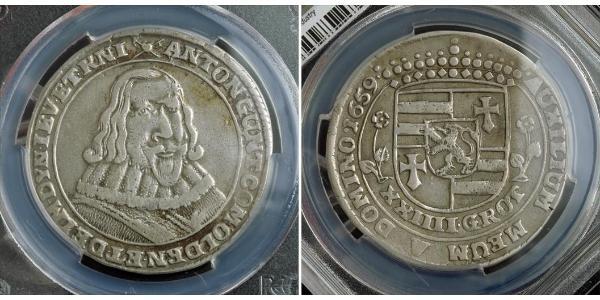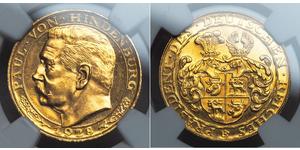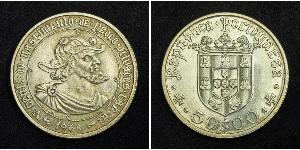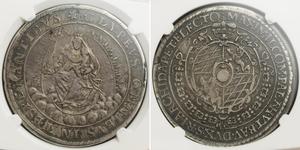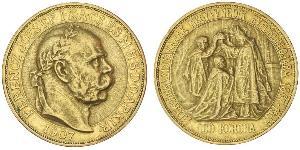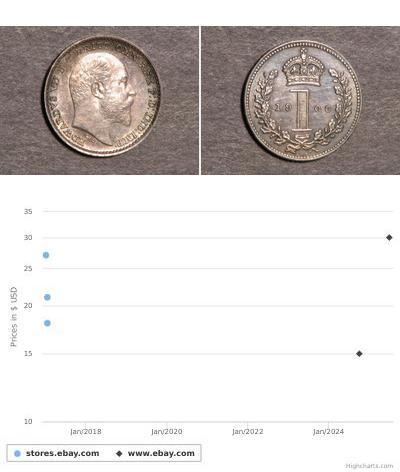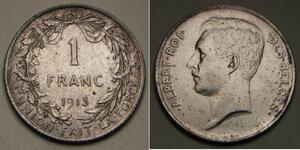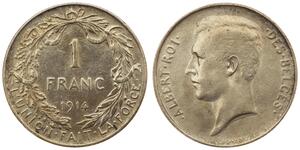1659, Jever, Count Anthony Gunther. Silver 24 Grote (Mark) Coin. R! PCGS VF-35! Mint Year: 1659 Mint Place: Jever Mint Master: Jurgen Hartmann (1658-1662) Denomination: 24 Grote (Mark = 1/3 Thaler) Condition: Certified and graded by PCGS as VF-35! Reference: Kalvelage/Trippler 188e, KM-42 ($750 in VF!). Material: Silver Obverse: Facing draped bust of the Count. Mint master`s mark (heart with mint hooks in saltire) splitting legend above. Legend: ANTON GUNT COM OLDEN ET DEIM DYN IEV ET KNI Reverse: Crowned shield with farms of Oldenburg and Jever, flanked by two roses. Value in Grote (XIIII . GROT) below. Legend: AUXILIUM MEUM A DOMINO 1659 Jever was granted rights as a town in 1347. Around the turn of the 15th century the town continued to be a prosperous trading center, this attracted not only merchants but also pirates. The most famous of the pirates was a band who were known as the "Likedeeler", and included Klaus Störtebeker and Goedeke Michels. The last Baron of the Jeverland was Edo Wiemken who, in 1505, completed the reconstruction of the castle and is buried in the city church. After Edo's death Jever came under the control of Graf Edward I. However Maria of Jever, the daughter of Edo restored the city's independence, and in 1536 whilst under her rule Jever received its city rights which has led to the city's unofficial title as "Marienstadt". Maria died in 1575 but her death was kept secret for fear of a return of the East Frisians. Instead, Jever became one of Oldenburg's territories by last will of Maria. In 1667 Jever was through distaff passed under control of the Anhalt-Zerbst. After Prince Frederick August, who had supported the English in the American Revolutionary War for financial reasons, died in 1793, the male-line of Anhalt-Zerbst perished and its territories were split. Jeverland was then given to Catherine II of Russia, formerly Princess Sophia of Anhalt-Zerbst and Frederick August's sole surviving sibling. It remained Russian until Napoleon's armies occupied it in 1807. Between 1808 and 1810 it was part of the Kingdom of Holland, a Napoleonic vassal state. When the French were forced to withdraw in 1813, Russia regained possession of Jever and gave it to the new grand dukes of Oldenburg in 1818. Jever was connected to the railway network in 1871 by a line from Sande. From 1881, a line connected it westwards to Wittmund, Esens and Dornum, and from 1888 there was a line northwards to Carolinensiel. The railway station in Jever still has a waiting room for the exclusive use of the Duke of Oldenburg to this day. Because Anhalt-Zerbst had guaranteed security and freedom of business for Jews, Jever became a center of Jewish life in Frisia, reaching its peak in the late 19th century. Anthony Günther, Count of Oldenburg (10 November 1583 in Oldenburg – 19 June 1667 in Rastede) was an Imperial Count and a member of the House of Oldenburg. He was the ruling count of Oldenburg from 1603 until his death, and of Delmenhorst from 1647 until his death. He was the son of John VII (1540–1603) and Elisabeth of Schwarzburg-Blankenburg. He married Sophie Catherine (28 June 1617 – 22 November 1696), a daughter of Alexander, Duke of Schleswig-Holstein-Sonderburg and Dorothea of Schwarzburg-Sondershausen. Only 1$ shipping for each additional coin purchased!
читати далі

|
Добавив:
anonymous 2015-06-23 |
Similar Coin Groups
2025-06-14
- Історичні ціни на монету
2025-05-27
- Нова монета додана до 1 Франк Бельгія Срібло
1 Франк Бельгія Срібло
в групі 4 монет / 4 цін
⇑
Belgium - 1 Franc 1914 - Albert I, Silver, French text
Можливо, Вас зацікавить...

